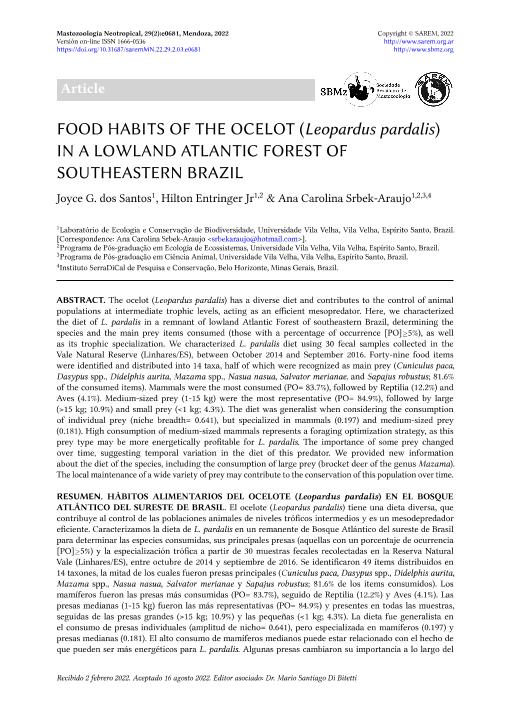Mostrar el registro sencillo del ítem
dc.contributor.author
Dos Santos, Joyce G.
dc.contributor.author
Entringer Júnior, Hilton

dc.contributor.author
Srbek Araujo, Ana Carolina
dc.date.available
2023-11-23T16:53:20Z
dc.date.issued
2022-12
dc.identifier.citation
Dos Santos, Joyce G.; Entringer Júnior, Hilton; Srbek Araujo, Ana Carolina; Food habits of the ocelot (leopardus pardalis) in a lowland atlantic forest of southeastern Brazil; Consejo Nacional de Investigaciones Científicas y Técnicas. Instituto Argentino de Investigación de Las Zonas Áridas. Unidad de Zoología y Ecología Animal; Mastozoología Neotropical; 29; 2; 12-2022; 1-8
dc.identifier.issn
0327-9383
dc.identifier.uri
http://hdl.handle.net/11336/218552
dc.description.abstract
The ocelot (Leopardus pardalis) has a diverse diet and contributes to the control of animal populations at intermediate trophic levels, acting as an e cient mesopredator. Here, we characterized the diet of L. pardalis in a remnant of lowland Atlantic Forest of southeastern Brazil, determining the species and the main prey items consumed (those with a percentage of occurrence [PO]≥5%), as well as its trophic specialization. We characterized L. pardalis diet using 30 fecal samples collected in the Vale Natural Reserve (Linhares/ES), between October 2014 and September 2016. Forty-nine food items were identi ed and distributed into 14 taxa, half of which were recognized as main prey (Cuniculus paca, Dasypus spp., Didelphis aurita, Mazama spp., Nasua nasua, Salvator merianae, and Sapajus robustus; 81.6% of the consumed items). Mammals were the most consumed (PO= 83.7%), followed by Reptilia (12.2%) and Aves (4.1%). Medium-sized prey (1-15 kg) were the most representative (PO= 84.9%), followed by large (>15 kg; 10.9%) and small prey (<1 kg; 4.3%). The diet was generalist when considering the consumption of individual prey (niche breadth= 0.641), but specialized in mammals (0.197) and medium-sized prey (0.181). High consumption of medium-sized mammals represents a foraging optimization strategy, as this prey type may be more energetically pro table for L. pardalis. The importance of some prey changed over time, suggesting temporal variation in the diet of this predator. We provided new information about the diet of the species, including the consumption of large prey (brocket deer of the genus Mazama). The local maintenance of a wide variety of prey may contribute to the conservation of this population over time.
dc.description.abstract
El ocelote (Leopardus pardalis) tiene una dieta diversa, que contribuye al control de las poblaciones animales de niveles tró cos intermedios y es un mesodepredador e ciente. Caracterizamos la dieta de L. pardalis en un remanente de Bosque Atlántico del sureste de Brasil para determinar las especies consumidas, sus principales presas (aquellas con un porcentaje de ocurrencia [PO]≥5%) y la especialización tró ca a partir de 30 muestras fecales recolectadas en la Reserva Natural Vale (Linhares/ES), entre octubre de 2014 y septiembre de 2016. Se identi caron 49 ítems distribuidos en 14 taxones, la mitad de los cuales fueron presas principales (Cuniculus paca, Dasypus spp., Didelphis aurita, Mazama spp., Nasua nasua, Salvator merianae y Sapajus robustus; 81.6% de los ítems consumidos). Los mamíferos fueron las presas más consumidas (PO= 83.7%), seguido de Reptilia (12.2%) y Aves (4.1%). Las presas medianas (1-15 kg) fueron las más representativas (PO= 84.9%) y presentes en todas las muestras, seguidas de las presas grandes (>15 kg; 10.9%) y las pequeñas (<1 kg; 4.3%). La dieta fue generalista en el consumo de presas individuales (amplitud de nicho= 0.641), pero especializada en mamíferos (0.197) y presas medianas (0.181). El alto consumo de mamíferos medianos puede estar relacionado con el hecho de que pueden ser más energéticos para L. pardalis. Algunas presas cambiaron su importancia a lo largo del tiempo, lo que sugiere una variación temporal en la dieta. Proporcionamos nueva información sobre la dieta de la especie, que incluye el consumo de presas grandes (cérvidos del género Mazama). El mantenimiento local de una amplia variedad de presas puede contribuir a la conservación de esta población a lo largo del tiempo
dc.format
application/pdf
dc.language.iso
spa
dc.publisher
Consejo Nacional de Investigaciones Científicas y Técnicas. Instituto Argentino de Investigación de Las Zonas Áridas. Unidad de Zoología y Ecología Animal

dc.rights
info:eu-repo/semantics/openAccess
dc.rights.uri
https://creativecommons.org/licenses/by-nc-sa/2.5/ar/
dc.subject
ECOLOGICAL INTERACTION
dc.subject
FELIDAE
dc.subject
MESOPREDATOR
dc.subject
TROPHIC ECOLOGY
dc.subject
TROPHIC NICHE
dc.subject.classification
Ecología

dc.subject.classification
Ciencias Biológicas

dc.subject.classification
CIENCIAS NATURALES Y EXACTAS

dc.title
Food habits of the ocelot (leopardus pardalis) in a lowland atlantic forest of southeastern Brazil
dc.title
Hábitos alimentarios del ocelote (leopardus pardalis) en el bosque atlántico del sureste de Brasil
dc.type
info:eu-repo/semantics/article
dc.type
info:ar-repo/semantics/artículo
dc.type
info:eu-repo/semantics/publishedVersion
dc.date.updated
2023-11-15T15:45:25Z
dc.journal.volume
29
dc.journal.number
2
dc.journal.pagination
1-8
dc.journal.pais
Argentina

dc.description.fil
Fil: Dos Santos, Joyce G.. Universidade Vila Velha; Brasil
dc.description.fil
Fil: Entringer Júnior, Hilton. Universidade Vila Velha; Brasil. Consejo Nacional de Investigaciones Científicas y Técnicas; Argentina
dc.description.fil
Fil: Srbek Araujo, Ana Carolina. Universidade Vila Velha; Brasil
dc.journal.title
Mastozoología Neotropical

dc.relation.alternativeid
info:eu-repo/semantics/altIdentifier/url/https://mn.sarem.org.ar/article/food-habits-of-leopardus-pardalis-in-a-lowland-atlantic-forest-of-brazil/
dc.relation.alternativeid
info:eu-repo/semantics/altIdentifier/doi/http://dx.doi.org/10.31687/saremMN.22.29.2.03.e0681
Archivos asociados
